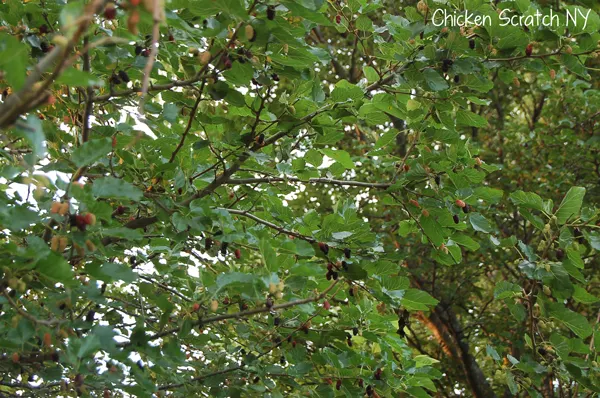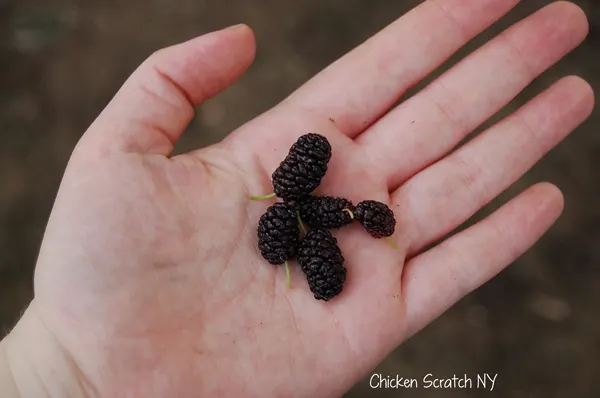When we moved in we were lucky enough to get a giant rhubarb patch, 5-ish grape vines and two mulberry trees. I was really excited about the first two, not so much with the mulberries. All I could think was “I guess I’ve got something to chase a weasel around…” After living with the two trees for a few summers I can confidently say they’ve won me over.
As it turns out the two trees are worth a lot more than their place in nursery rhymes suggest. Unfortunately they also have a few negatives, but in the long run I think they’re totally forgivable. Since we didn’t plant the trees I don’t know what type they are but I do know we get tons of purple/black fruit each summer.
- Size: 30-50 ft Tall (the two on the left next to the barn are our mulberry trees, the barn quilt is 4×4 so about 30-35 ft tall)
- Species: White Mulberry (Morus alba), Red Mulberry (Morus rubra), Black Mulberry (Morus nigra) – Oddly the species name does not reflect the berry color. White mulberry trees can have white, red or black berries
- Zones 4-8 depending on species. Late blossoms mean crops are usually protected from frost
- Require full sun and 15 ft of space on (ours were planted closer and hasn’t stopped them from producing fruit)
Pro’s:
- SO MANY BERRIES! Even though they’re about the size of a black berry they grow on trees covered with berries so you get tons and tons of them. Mature trees can produce 10 bushels of fruit a year (can I get a” holy cow!”?)
- Long harvest time – we start picking them in late June/early July and pick through summer. They ripen in waves so if you miss one harvest the next one is right around the corner.
- Easy to pick – they fall off in your hand when ripe so there’s no guessing when they’re ripe
- Sweet-tart flavor – not quite like anything else. They are good for fresh eating, pies, jelly and baked goods. You can use them like black berries and raspberries.
- Fragile – seems like an odd pro but because they’re so fragile you won’t find them fresh in a store so if you want to eat them you need to grow them.
- Possible to harvest by shaking – spread a clean sheet (not one you care about) under the tree and shake the limbs, ripe berries will fall to the ground. Pour everything into a large bucket and fill with water, ripe berries will sink, everything that floats can be discarded.
- No major pests
- Require little pruning once established
- The berries stain everything. Your hands, your lawn, your baby. Mary loves the sweet berries but they turned her purple. Mulberries are currently on the naked eating list.
- They stain going in and out. All the berries the birds eat turn the bird poop into purple missiles. I can always tell when they are ripe because the chickens start pooping purple.
- They drop off the tree when ripe on awindy day or during any rainfall. Keep the trees away from patios, decks, pools, cars ect and you can avoid any major staining issues. If you can’t put one somewhere where it won’t damage anything look for a variety with white berries or maybe they aren’t for you.
- Stems – they come off the tree with fruit so you can pick them out or just eat them (I eat them, but I also swallow watermelon seeds)
- Variable flavor – last year we had flooding and torrential rains all through July, the berries ripened with a bland washed out flavor. The later ones had good flavor though
Cornell Coop – Mulberries
Recommended Book Reading (amazon affiliate links):
Uncommon Fruits for Every Garden
Tree Sources:




